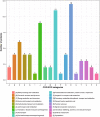High-generation near-isogenic lines combined with multi-omics to study the mechanism of polima cytoplasmic male sterility
- PMID: 33673810
- PMCID: PMC7934456
- DOI: 10.1186/s12870-021-02852-7
High-generation near-isogenic lines combined with multi-omics to study the mechanism of polima cytoplasmic male sterility
Abstract
Background: Cytoplasmic male sterility (CMS), which naturally exists in higher plants, is a useful mechanism for analyzing nuclear and mitochondrial genome functions and identifying the role of mitochondrial genes in the plant growth and development. Polima (pol) CMS is the most universally valued male sterility type in oil-seed rape. Previous studies have described the pol CMS restorer gene Rfp and the sterility-inducing gene orf224 in oil-seed rape, located in mitochondria. However, the mechanism of fertility restoration and infertility remains unknown. Moreover, it is still unknown how the fecundity restorer gene interferes with the sterility gene, provokes the sterility gene to lose its function, and leads to fertility restoration.
Result: In this study, we used multi-omics joint analysis to discover candidate genes that interact with the sterility gene orf224 and the restorer gene Rfp of pol CMS to provide theoretical support for the occurrence and restoration mechanisms of sterility. Via multi-omics analysis, we screened 24 differential genes encoding proteins related to RNA editing, respiratory electron transport chain, anther development, energy transport, tapetum development, and oxidative phosphorylation. Using a yeast two-hybrid assay, we obtained a total of seven Rfp interaction proteins, with orf224 protein covering five interaction proteins.
Conclusions: We propose that Rfp and its interacting protein cleave the transcript of atp6/orf224, causing the infertility gene to lose its function and restore fertility. When Rfp is not cleaved, orf224 poisons the tapetum cells and anther development-related proteins, resulting in pol CMS mitochondrial dysfunction and male infertility. The data from the joint analysis of multiple omics provided information on pol CMS's potential molecular mechanism and will help breed B. napus hybrids.
Keywords: Brassica napus; CMS; Multi-omics analysis; Polima; Rfp; orf224.
Conflict of interest statement
The authors declare that they have no conflict of interest.
Figures







Similar articles
-
Molecular Analysis Uncovers the Mechanism of Fertility Restoration in Temperature-Sensitive Polima Cytoplasmic Male-Sterile Brassica napus.Int J Mol Sci. 2021 Nov 18;22(22):12450. doi: 10.3390/ijms222212450. Int J Mol Sci. 2021. PMID: 34830333 Free PMC article.
-
Comparative transcript profiling of the fertile and sterile flower buds of pol CMS in B. napus.BMC Genomics. 2014 Apr 3;15:258. doi: 10.1186/1471-2164-15-258. BMC Genomics. 2014. PMID: 24707970 Free PMC article.
-
Transcriptional control of orf224/atp6 by the pol CMS restorer Rfp gene in Brassica napus L.Yi Chuan Xue Bao. 2003 May;30(5):469-73. Yi Chuan Xue Bao. 2003. PMID: 12924163
-
An overview of cytoplasmic male sterility in Brassica napus.Funct Plant Biol. 2025 May;52:FP24337. doi: 10.1071/FP24337. Funct Plant Biol. 2025. PMID: 40310995 Review.
-
Mechanism and Utilization of Ogura Cytoplasmic Male Sterility in Cruciferae Crops.Int J Mol Sci. 2022 Aug 13;23(16):9099. doi: 10.3390/ijms23169099. Int J Mol Sci. 2022. PMID: 36012365 Free PMC article. Review.
Cited by
-
Complete mitochondrial genome sequencing and identification of candidate genes responsible for C5-type cytoplasmic male sterility in cabbage (B. oleracea var. capitata).Front Plant Sci. 2022 Sep 26;13:1019513. doi: 10.3389/fpls.2022.1019513. eCollection 2022. Front Plant Sci. 2022. PMID: 36226295 Free PMC article.
-
Single-cell transcriptomic and cell‑type‑specific regulatory networks in Polima temperature-sensitive cytoplasmic male sterility of Brassica napus L.BMC Plant Biol. 2024 Dec 19;24(1):1206. doi: 10.1186/s12870-024-05916-6. BMC Plant Biol. 2024. PMID: 39701979 Free PMC article.
-
Omics and Male Infertility: Highlighting the Application of Transcriptomic Data.Life (Basel). 2022 Feb 14;12(2):280. doi: 10.3390/life12020280. Life (Basel). 2022. PMID: 35207567 Free PMC article. Review.
-
Unraveling the Genetic Basis of Fertility Restoration for Cytoplasmic Male Sterile Line WNJ01A Originated From Brassica juncea in Brassica napus.Front Plant Sci. 2021 Aug 31;12:721980. doi: 10.3389/fpls.2021.721980. eCollection 2021. Front Plant Sci. 2021. PMID: 34531887 Free PMC article.
-
Embryo Rescue in Plant Breeding.Plants (Basel). 2023 Aug 29;12(17):3106. doi: 10.3390/plants12173106. Plants (Basel). 2023. PMID: 37687352 Free PMC article. Review.
References
-
- Chase CD, Gabay-Laughnan S. Cytoplasmic Male Sterility and Fertility Restoration by Nuclear Genes BT- Molecular Biology and Biotechnology of Plant Organelles: Chloroplasts and mitochondria. 2004. p. 593–621.
MeSH terms
Substances
Grants and funding
LinkOut - more resources
Full Text Sources
Other Literature Sources

